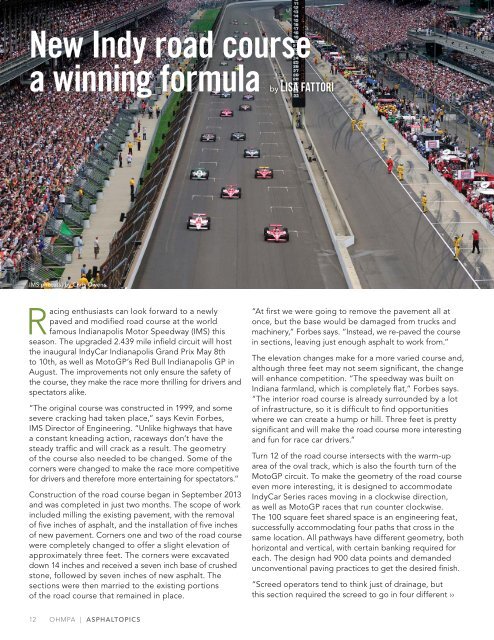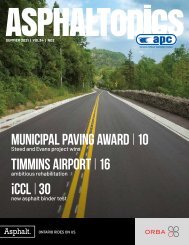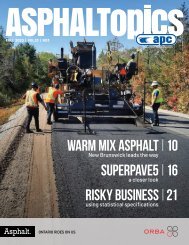ASPHALTopics | Spring 2014 | VOL 27 | NO 1
Create successful ePaper yourself
Turn your PDF publications into a flip-book with our unique Google optimized e-Paper software.
New Indy road course<br />
a winning formula<br />
by Lisa Fattori<br />
IMS photo(s) by Chris Owens.<br />
Racing enthusiasts can look forward to a newly<br />
paved and modified road course at the world<br />
famous Indianapolis Motor Speedway (IMS) this<br />
season. The upgraded 2.439 mile infield circuit will host<br />
the inaugural IndyCar Indianapolis Grand Prix May 8th<br />
to 10th, as well as MotoGP’s Red Bull Indianapolis GP in<br />
August. The improvements not only ensure the safety of<br />
the course, they make the race more thrilling for drivers and<br />
spectators alike.<br />
“The original course was constructed in 1999, and some<br />
severe cracking had taken place,” says Kevin Forbes,<br />
IMS Director of Engineering. “Unlike highways that have<br />
a constant kneading action, raceways don’t have the<br />
steady traffic and will crack as a result. The geometry<br />
of the course also needed to be changed. Some of the<br />
corners were changed to make the race more competitive<br />
for drivers and therefore more entertaining for spectators.”<br />
Construction of the road course began in September 2013<br />
and was completed in just two months. The scope of work<br />
included milling the existing pavement, with the removal<br />
of five inches of asphalt, and the installation of five inches<br />
of new pavement. Corners one and two of the road course<br />
were completely changed to offer a slight elevation of<br />
approximately three feet. The corners were excavated<br />
down 14 inches and received a seven inch base of crushed<br />
stone, followed by seven inches of new asphalt. The<br />
sections were then married to the existing portions<br />
of the road course that remained in place.<br />
“At first we were going to remove the pavement all at<br />
once, but the base would be damaged from trucks and<br />
machinery,” Forbes says. “Instead, we re-paved the course<br />
in sections, leaving just enough asphalt to work from.”<br />
The elevation changes make for a more varied course and,<br />
although three feet may not seem significant, the change<br />
will enhance competition. “The speedway was built on<br />
Indiana farmland, which is completely flat,” Forbes says.<br />
“The interior road course is already surrounded by a lot<br />
of infrastructure, so it is difficult to find opportunities<br />
where we can create a hump or hill. Three feet is pretty<br />
significant and will make the road course more interesting<br />
and fun for race car drivers.”<br />
Turn 12 of the road course intersects with the warm-up<br />
area of the oval track, which is also the fourth turn of the<br />
MotoGP circuit. To make the geometry of the road course<br />
even more interesting, it is designed to accommodate<br />
IndyCar Series races moving in a clockwise direction,<br />
as well as MotoGP races that run counter clockwise.<br />
The 100 square feet shared space is an engineering feat,<br />
successfully accommodating four paths that cross in the<br />
same location. All pathways have different geometry, both<br />
horizontal and vertical, with certain banking required for<br />
each. The design had 900 data points and demanded<br />
unconventional paving practices to get the desired finish.<br />
“Screed operators tend to think just of drainage, but<br />
this section required the screed to go in four different ››<br />
12 OHMPA | ASPHALTOPICS


















